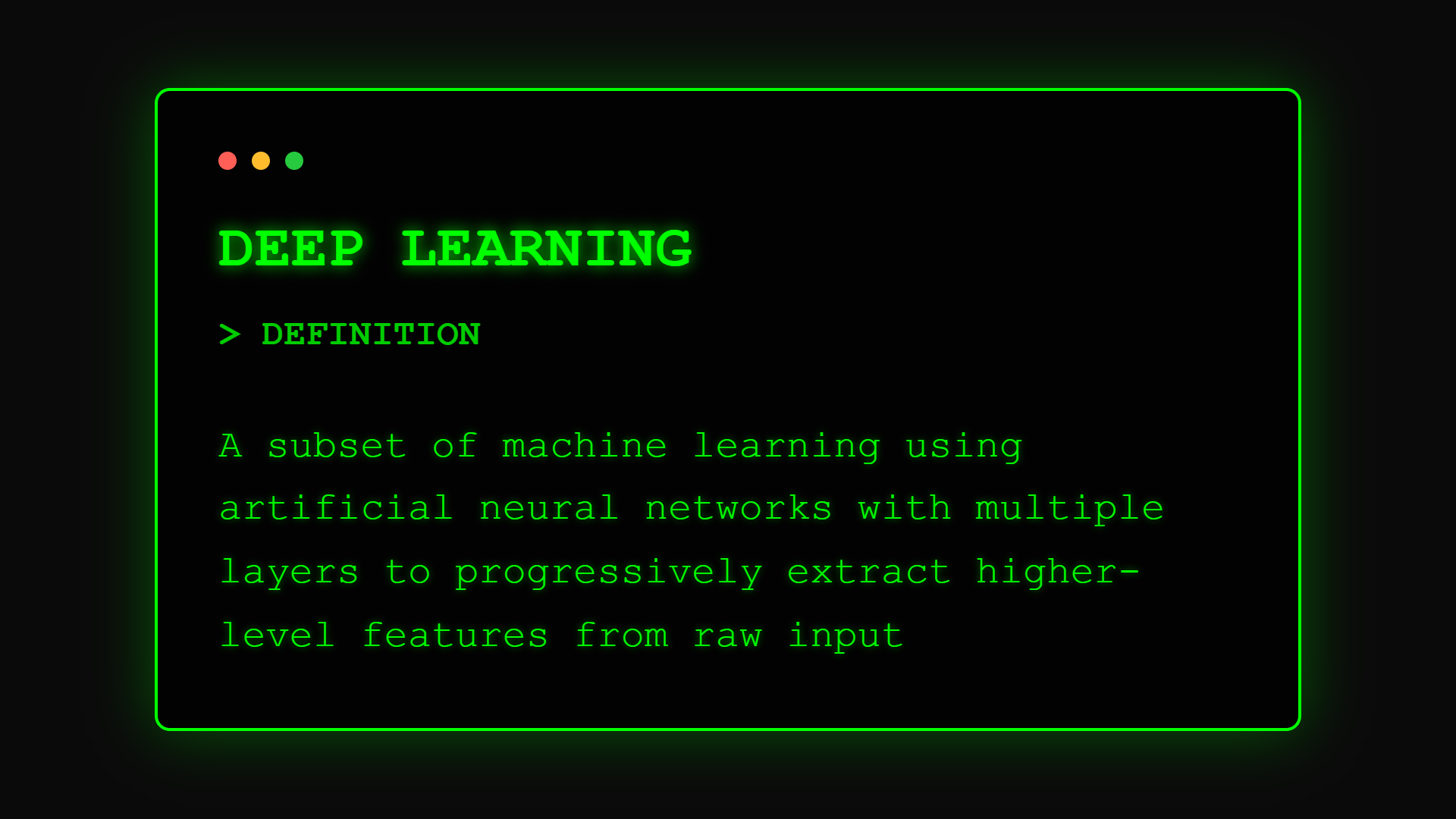AI Terms
What is Deep Learning? AI That Learns Like Your Brain

Traditional AI struggles with complexity: recognizing faces, understanding speech, or predicting market trends with hundreds of variables. Deep learning breaks through these barriers by mimicking how your brain processes information through layers of understanding, enabling breakthroughs that seemed impossible just years ago.
The Evolution of Deep Learning
Deep learning emerged from artificial neural network research in the 1980s, but the term was popularized by Geoffrey Hinton in 2006. The "deep" refers to multiple layers of processing, inspired by the human brain's layered structure.
According to the MIT Technology Review, deep learning is defined as "a subset of machine learning based on artificial neural networks with multiple layers between input and output, allowing the modeling of complex non-linear relationships."
The field remained theoretical until three factors converged around 2012: massive datasets from the internet, powerful GPUs from gaming, and algorithmic improvements. This convergence enabled the training of networks deep enough to outperform traditional methods dramatically.
What Deep Learning Means for Business
For business leaders, deep learning means AI systems that can handle complex, nuanced tasks by processing information through multiple layers of analysis, like having a team of specialists who each add their expertise to solve difficult problems.
Think of deep learning as the difference between a basic calculator and a financial analyst. While simple AI follows rules, deep learning builds its own understanding by examining patterns from multiple angles, discovering insights humans might miss.
In practical terms, this enables systems that can accurately diagnose diseases from medical images, predict customer behavior from hundreds of factors, or optimize supply chains considering thousands of variables simultaneously.
Building Blocks of Deep Learning
Deep learning consists of these essential elements:
• Input Layer: The entry point for raw data like pixels for images, words for text, or numbers for business metrics
• Hidden Layers: Multiple processing layers that progressively extract higher-level features. Early layers might detect edges, middle layers recognize shapes, final layers identify complete objects
• Neurons & Connections: Artificial neurons that process information, connected by weights that strengthen or weaken based on learning
• Activation Functions: Mathematical functions that determine when neurons "fire," introducing non-linearity that enables complex pattern recognition
• Output Layer: The final layer that produces predictions, classifications, or decisions based on the accumulated processing
Understanding the Process
The deep learning process follows these steps:
Forward Propagation: Data flows through the network layer by layer, with each layer transforming the information like an assembly line where each station adds understanding
Error Calculation: The system compares its prediction to the correct answer, measuring how wrong it was, essential for learning from mistakes
Backward Propagation: The network adjusts its connections based on errors, strengthening patterns that led to correct answers and weakening those that didn't
This iterative process repeats millions of times, gradually building a model that can recognize incredibly complex patterns from subtle fraud indicators to early disease markers.
Four Types of Deep Networks
Deep learning generally falls into four main categories:
Type 1: Convolutional Neural Networks (CNNs) Best for: Image recognition, video analysis, medical imaging Key feature: Specialized for processing grid-like data Example: Tesla's autopilot recognizing road signs and pedestrians
Type 2: Recurrent Neural Networks (RNNs) Best for: Time series prediction, language translation, speech recognition Key feature: Memory of previous inputs for sequential data Example: Google Translate understanding context across sentences
Type 3: Generative Adversarial Networks (GANs) Best for: Creating synthetic data, image generation, simulation Key feature: Two networks competing to create realistic outputs Example: Creating photorealistic product images without photoshoots
Type 4: Transformer Networks Best for: Natural language processing, document analysis Key feature: Attention mechanisms that understand relationships Example: GPT models powering advanced chatbots
Deep Learning Success Stories
Here's how businesses actually use deep learning:
Financial Services Example: JPMorgan's deep learning system analyzes legal documents 150,000 times faster than lawyers, extracting key information with 99% accuracy while identifying risks humans often miss.
Retail Example: Amazon's deep learning recommendation engine analyzes billions of interactions to predict purchases, driving 35% of revenue through personalized suggestions.
Healthcare Example: Google's deep learning model detects breast cancer in mammograms with 89% accuracy, outperforming human radiologists who average 73%.
Your Next Steps
Ready to leverage deep learning in your business?
- Start with Machine Learning fundamentals
- Explore Neural Networks architecture basics
- Understand Computer Vision applications
- Implement with our Deep Learning Business Guide
FAQ Section
Frequently Asked Questions about Deep Learning
Part of the [AI Terms Collection]. Last updated: 2025-01-10